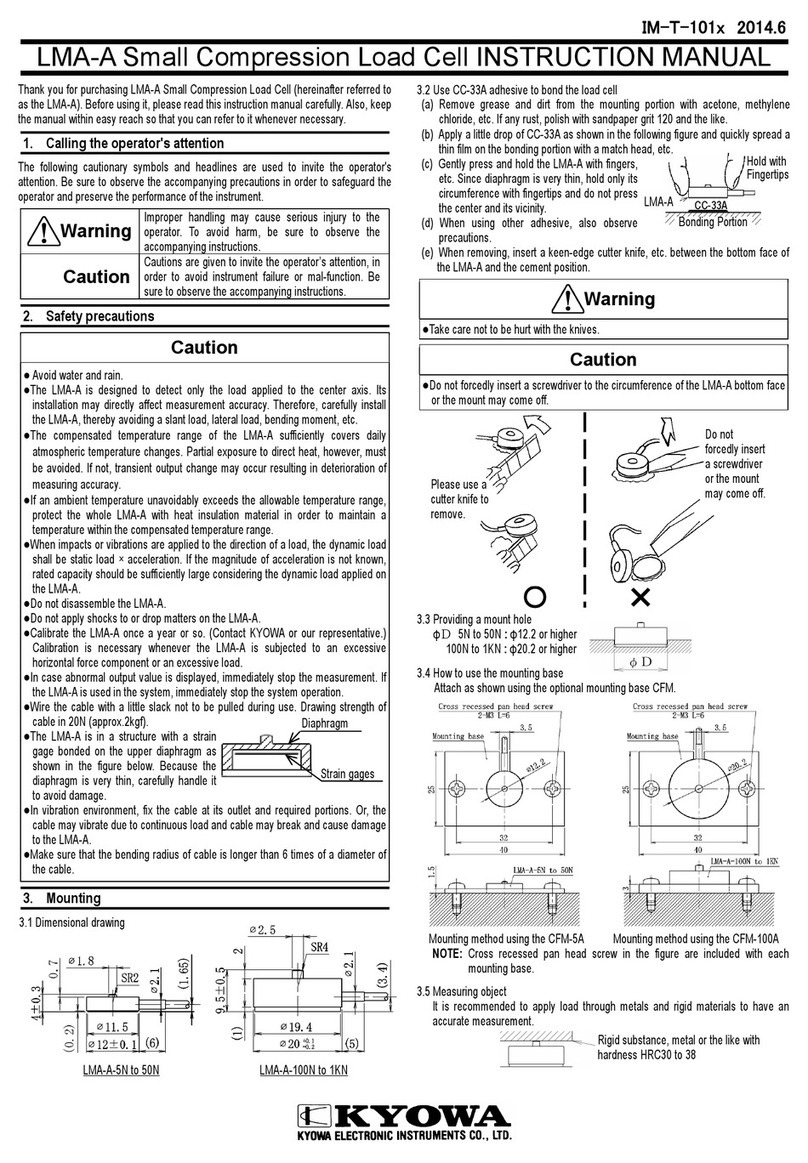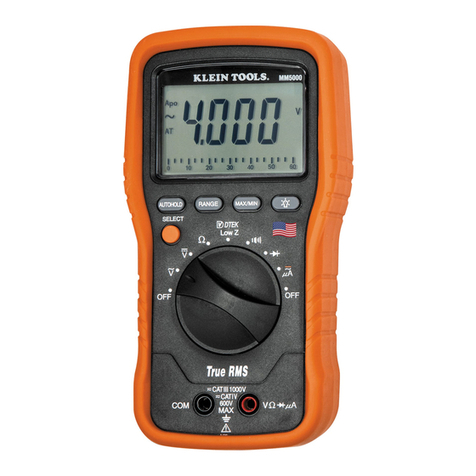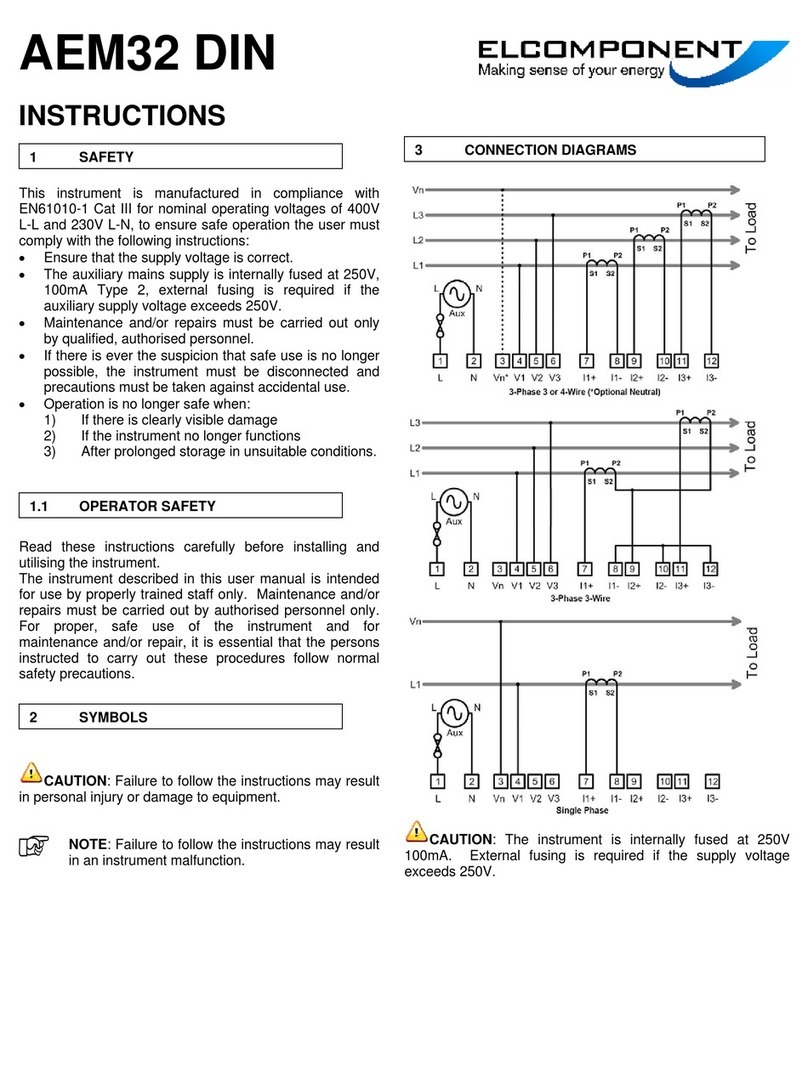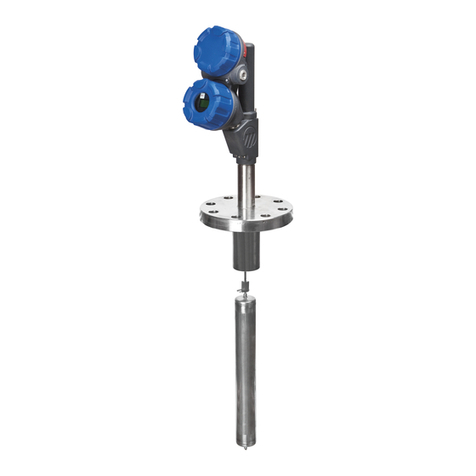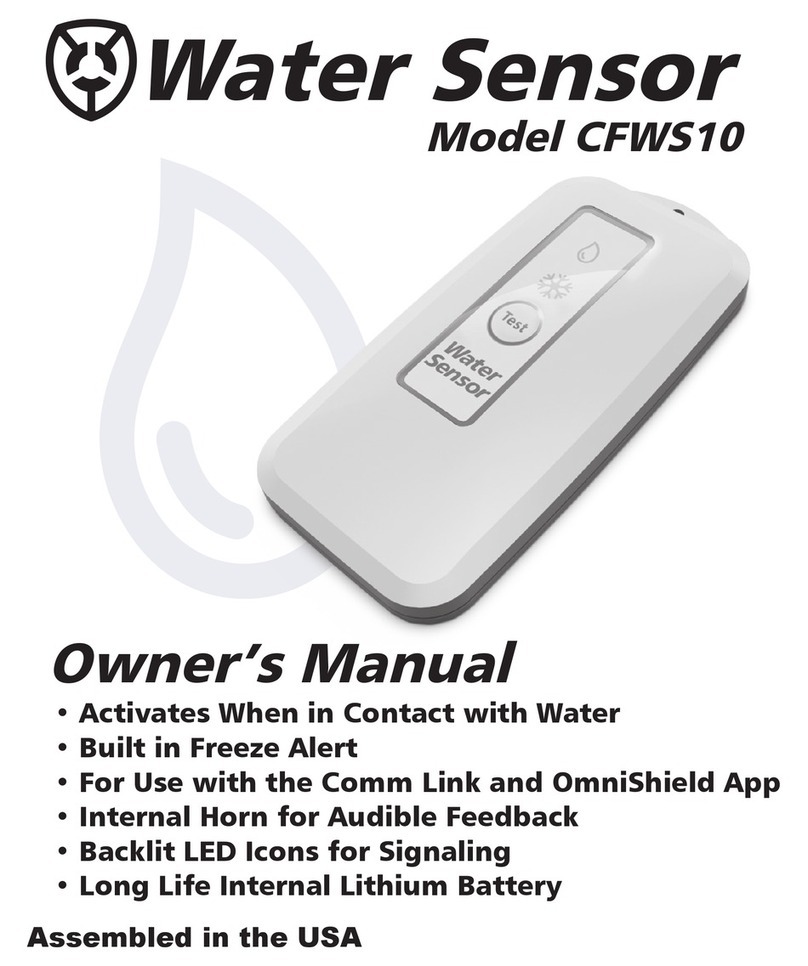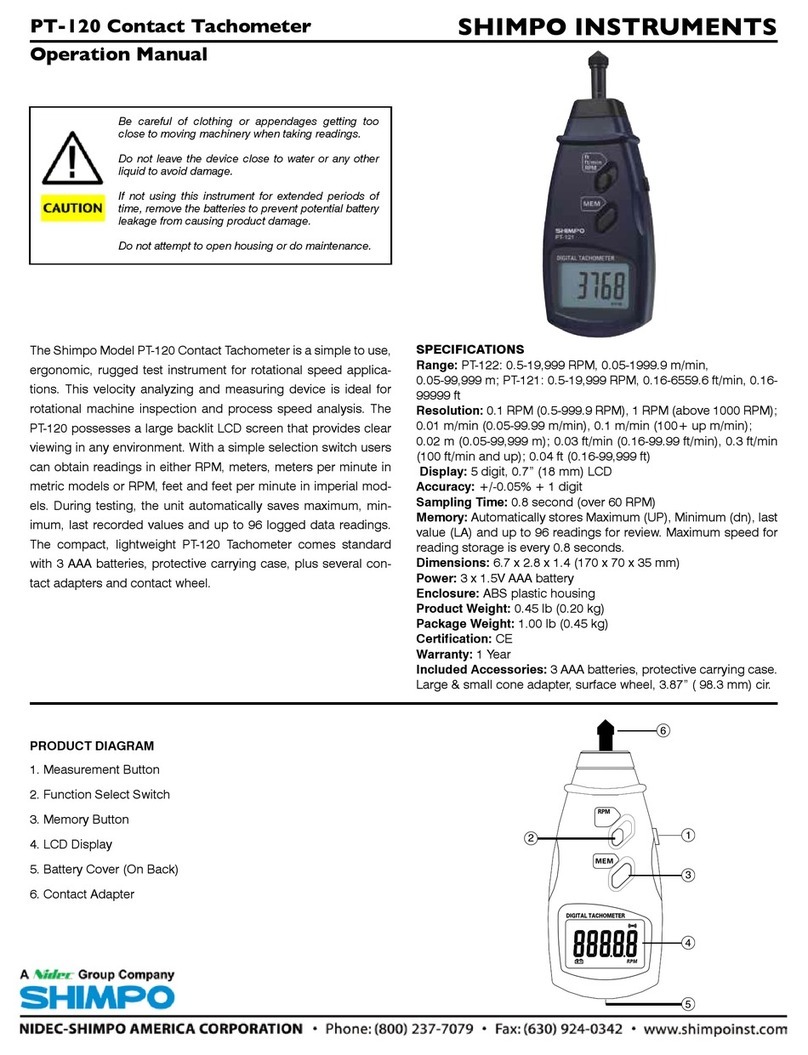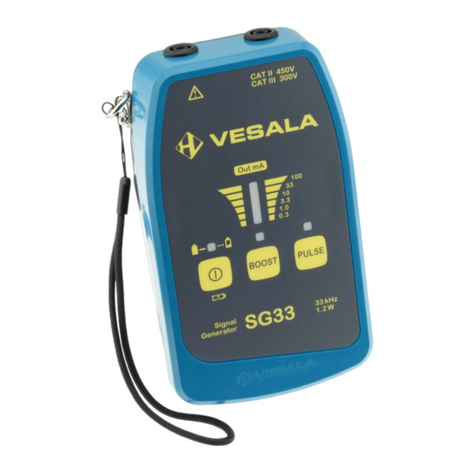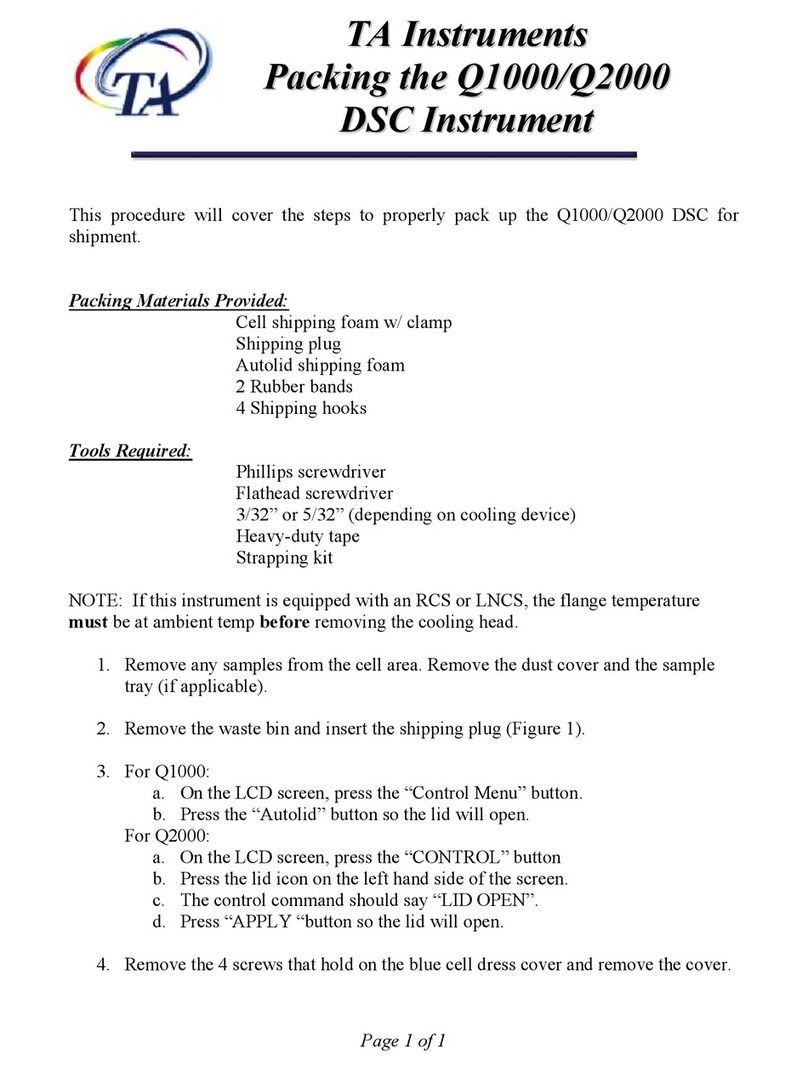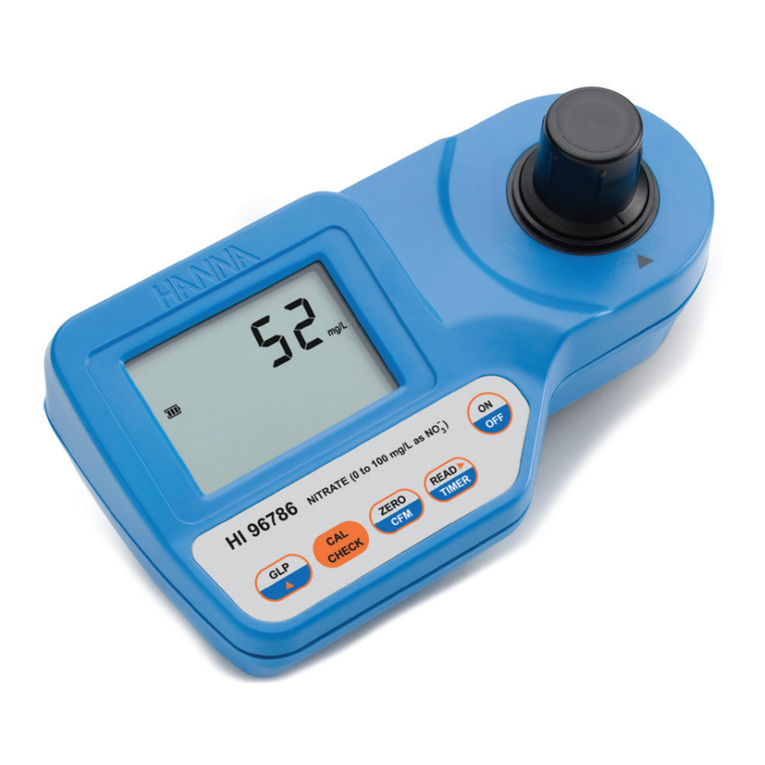GHM-Messtechnik GMH 3851 ab User manual

H60.0.13.6C-17
GHM Messtechnik GmbH - Standort Greisinger
Hans-Sachs-Str. 26 - 93128 Regenstauf GERMANY
+49 9402 / 9383-0 +49 9402 / 9383-33 info@greisinger.de
Operating Manual
Resistive Moisture And Temperature Measuring Instrument
With Data Logger And Programmable User Curves
ab Version 2.2
GMH 3851
Please carefully read these
instructions before use!
WEEE-Reg.-Nr. DE 93889386
Please consider the safety instructions!
Please keep for future reference!

H60.0.13.6C-17 Operating Manual GMH 3851 Page 2 of 22
_____________________________________________________ _____________________________________________________________________________
Index
1GENERAL NOTE......................................................................................................................................................3
2SAFETY......................................................................................................................................................................3
2.1 INTENDED USE.......................................................................................................................................................3
2.2 SAFETY SIGNS AND SYMBOLS................................................................................................................................3
2.3 SAFETY INSTRUCTIONS .........................................................................................................................................3
3PRODUCT DESCRIPTION......................................................................................................................................4
3.1 SCOPE OF SUPPLY ..................................................................................................................................................4
3.2 OPERATING AND MAINTENANCE...........................................................................................................................4
3.3 START UP AND READINESS FOR OPERATION..........................................................................................................4
3.4 CONNECTIONS .......................................................................................................................................................5
3.5 DISPLAY ELEMENTS ..............................................................................................................................................5
3.6 KEYPAD.................................................................................................................................................................5
4DEVICE CONFIGURATION...................................................................................................................................6
5SOME BASICS OF PRECISION MATERIAL MOISTURE MEASURING......................................................7
5.1 MEASURING METHOD ...........................................................................................................................................7
5.2 MOISTURE CONTENT UAND WET-BASIS MOISTURE CONTENT W........................................................................7
5.3 SPECIAL FEATURES OF THE DEVICE.......................................................................................................................7
5.4 AUTO-HOLD FUNCTION.........................................................................................................................................7
5.5 AUTOMATIC TEMPERATURE-COMPENSATION ('ATC') ...........................................................................................7
5.6 MEASURING IN WOOD:MEASURING WITH TWO MEASURING-NEEDLES.............................................................8
5.7 SPLIT LOG FIREWOOD MEASURING........................................................................................................................8
5.7.1 Presetting.......................................................................................................................................................8
5.7.2 Sampling ........................................................................................................................................................8
5.7.3 Measuring......................................................................................................................................................9
5.8 MEASURING OTHER MATERIALS ........................................................................................................................10
5.8.1 ‘Hard‘ Materials (concrete or similar): Measuring with brush-type probes (GBSL91 or GBSK91)............10
5.8.2 ‘Soft‘ Materials (polystyrene or similar): Measuring with Measuring-rods or -pins (GMS 300/91)...........10
5.8.3 Measuring bulk cargo, bales and other special measures...........................................................................10
5.9 MEASURING OF MATERIALS,HAVING NO CHARACTERISTIC CURVES STORED ....................................................10
6HINTS FOR SPECIAL FUNCTIONS ...................................................................................................................11
6.1 MOISTURE EVALUATION ('WET' -'MEDIUM' -'DRY')...................................................................................11
6.2 PRE-SELECTION OF FAVOURITE MATERIALS ('SORT')..........................................................................................11
6.3 INDIVIDUALLY PROGRAMMABLE CHARACTERISTIC CURVES.............................................................................11
7OPERATION OF LOGGER...................................................................................................................................12
7.1 “FUNC-STOR“: STORING SINGLE MEASUREMENTS.............................................................................................12
7.2 “FUNC-CYCL“: AUTOMATIC RECORDING WITH SELECTABLE LOGGER-CYCLE-TIME .....................................13
8OUTPUT ...................................................................................................................................................................14
8.1 INTERFACE -BASE ADDRESS ('ADR.') .................................................................................................................14
8.2 ANALOGUE OUTPUT –SCALING WITH DAC.0 AND DAC.1................................................................................14
9APPLICATION IN THE GLUED TIMBER CONSTRUCTION AND LAMINATED TIMBER PRODUCTION.............................14
10 FAULT AND SYSTEM MESSAGES.....................................................................................................................15
11 INSPECTION OF THE ACCURACY / ADJUSTMENT SERVICES................................................................15
12 RESHIPMENT AND DISPOSAL...........................................................................................................................15
13 SPECIFICATION....................................................................................................................................................16
14 APPENDIX A: SORTS OF WOOD .......................................................................................................................17
15 APPENDIX B: ADDITIONAL MATERIALS ......................................................................................................22
15.1 MEASURING OF BUILDING MATERIALS ............................................................................................................22
15.2 MEASURING OF AGRICULTURAL BULK CARGO................................................................................................22
15.3 ESTIMATION OF ADDITIONAL MATERIALS .......................................................................................................22

H60.0.13.6C-17 Operating Manual GMH 3851 Page 3 of 22
_____________________________________________________ _____________________________________________________________________________
1 General note
Read through this document attentively and make yourself familiar to the operation of the device before you
use it. Keep this document in a ready-to-hand way in order to be able to look up in the case of doubt.
2 Safety
2.1 Intended use
The device is suitable for the measurement of moisture content and temperature.
The measurement is done using appropriate electrodes and cables. The electrodes are connected via a BNC
(moisture) or thermocouple connector (temperature).
It is designed for the mobile use or the stationary operation in a controlled electromagnetic environment (lab).
The electrodes are connected via 7-pole bayonet connection.
Personnel which starts up, operates and maintains the device has to have sufficient knowledge of the
measuring procedure and the meaning of the resulting measured values, this manual delivers a valuable
help for this. The instructions of the manual have to be understood, regarded and followed.
To be sure that there´s no risk arising due to misinterpretation of measured values, the operator must have
further knowledge in case of doubt - the user is liable for any harm/damage resulting from misinterpretation
due to insufficient knowledge.
The manufacturer will assume no liability or warranty in case of usage for other purpose than the intended
one, ignoring this manual, operating by unqualified staff as well as unauthorized modifications to the device.
2.2 Safety signs and symbols
Warning notices are marked in this manual as shown below:
Caution! This symbol warns of imminent danger, death, serious injuries and significant
damage to property at non-observance.
Attention! This symbol warns of possible dangers or dangerous situations which can
provoke damage to the device or environment at non-observance.
Note! This symbol point out processes which can indirectly influence operation, possibly
cause incorrect measurement or provoke unforeseen reactions at non-observance.
2.3 Safety instructions
This device has been designed and tested in accordance to the safety regulations for electronic devices.
However, its trouble-free operation and reliability cannot be guaranteed unless the standard safety measures
and special safety advises given in this manual will be adhered to when using it.
1.
Trouble-free operation and reliability of the device can only be guaranteed if it is not subjected to any
other climatic conditions than those stated under “Specification”.
Transporting the device from a cold to a warm environment condensation may result in a failure of the
function. In such a case make sure the device temperature has adjusted to the ambient temperature
before trying a new start-up.
2.
Whenever there may be a risk whatsoever involved in running it, the device has to be
switched off immediately and to be marked accordingly to avoid re-starting. Operator
safety may be a risk if:
- there is visible damage to the device
- the device is not working as specified
- the device has been stored under unsuitable conditions for a longer time
In case of doubt, please return device to manufacturer for repair or maintenance.

H60.0.13.6C-17 Operating Manual GMH 3851 Page 4 of 22
_____________________________________________________ _____________________________________________________________________________
3.
Do not use this product as safety or emergency stop device or in any other application
where failure of the product could result in personal injury or material damage.
Failure to comply with these instructions could result in death or serious injury and
material damage.
4.
This device must not be used at potentially explosive areas! The usage of this device at
potentially explosive areas increases danger of deflagration, explosion or fire due to
sparking.
5.
Risk of injury due to sharp measuring needles depending on the used electrode! Please
protect needles while not used with suitable means of protection.
3 Product description
3.1 Scope of supply
Handheld instrument
9V battery
Operating Manual
3.2 Operating and maintenance
1. Battery Operation
The battery has been used up and needs to be replaced, if ´bAt´ is shown in lower display. The device
will, however, continue operating correctly for a certain time.
The battery has been completely used up, if ´bAt´ is shown in the upper display.
2. The battery has to be removed, when storing device above 50°C.
We recommend to remove the battery if device is not used for a longer period of time!
Risk of leakage!
3. Treat device and probes carefully. Use only in accordance with above specification. (do not throw, hit
against etc.). Protect plugs and sockets from soiling.
4. Mains Operation
When using a power supply unit please note that operating voltage has to be 10.5 to 12 V
DC. Do not apply over voltage!! Simple 12V-power supplies often have excessive no-load
voltage. We, therefore, recommend using regulated voltage power supplies. Trouble-free
operation is guaranteed by our power supply GNG10/3000.
Prior to connecting the plug power supply with the mains supply make sure that the operating voltage
stated at the power supply is identical to the mains voltage.
5. Cable break or no connected / too dry / highly insulating material:
There may still corresponding %-values are displayed
- This shall not constitute a valid test result!
6. Maintenance: The device does not contain serviceable parts inside.
Regular inspection of contacts and cable is suggested, the precision of the measuring chain can be
checked with the optional testing adapter GPAD 38
The measuring needles have to be fixed very well e.g. by means of a wrench. Loose needles can disturb
the measuring.
3.3 Start up and readiness for operation
After switching on the instrument, a self test is performed (approximately 5 seconds).
During this time all display segments are shown.
After this sequence the instrument changes to measuring operation and is ready for use.

H60.0.13.6C-17 Operating Manual GMH 3851 Page 5 of 22
_____________________________________________________ _____________________________________________________________________________
3.4 Connections
1:
Output:
Operation as interface: Connect to optically isolated interface
adapter (accessory: GRS 3100 or USB 3100 N)
Operation as analogue output: Connection via suitable cable.
Attention: The output mode has to be configured (p.r.t chapter 8)
and influences battery life!
2:
Sensor-connection: BNC
3:
Temperature-probe-connection: Thermocouple type K (NiCr-
Ni) for temperature-compensation with an external temperature-
probe
4:
The mains socket is located at the left side of the instrument.
3.5 Display elements
1:
Main display: Currently measured material moisture
[percent moisture content]
HLD: Measure value is ‘frozen‘ (key 6)
2:
Auxiliary display: Currently selected material (temperature
when pressing key 3) Blinking display: Displayed value is out of
specified range (wood 8..40 %u)
Special display elements:
3:
Moisture evaluation: Evaluation of the material condition: via
top arrows: DRY - MEDIUM - WET
4:
Warning triangle: Indicates low battery
5:
“%u” or “%w”:Displays unit: moisture content u or wet basis
moisture content w
6:
T external-arrow: Appears if an external temperature-probe is
connected and automatic temperature compensation is activated.
7:
Logg-arrow: Shown if logger function is selected,
flashes if cyclic logger is running
All remaining arrows have no function in this version.
3.6 Keypad
1:
On/Off key
3:
During measurement: shortly displaying temperature
or changing to temperature input.
4:
Set/Menu: press (Menu) for 2 s: configuration will
activated
2 and 5:
During measurement: select a material
p.r.t.: 6.2 Pre-selection of favourite materials ('Sort')
List of selectable materials:
Appendix A; Appendix B
With manual temperature compensation:
When displaying temperature (call via button ‚Temp‘): Input of temperature
up/down for configuration:
to enter values or change settings
6:
During Measurement:
-with Auto-Hold off: Hold current measuring value ('HLD' in display)
-with Auto-Hold on: Start a new measure, which is ready when 'HLD' appears in
the display. refer to chapter 5.4 Auto-Hold function
-or calling of the logger functions (refer to chapter 7)
Set/Menu or temperature input:
confirming of selected input, return to measure

H60.0.13.6C-17 Operating Manual GMH 3851 Page 6 of 22
_____________________________________________________ _____________________________________________________________________________
4 Device configuration
Some menu items will be shown depending on the actual device configuration (e.g. there are
some items disabled when the logger contains data). Please note the hints by the menu items.
For configuration of the device press "Menu"-key (key 4) for 2 seconds, the main menu will be shown (main display:
“SEt”). Choose the desired menu branch by pressing the "Menu"-key (key 4). By pressing “” (key 3) the referring
parameters can be chosen. The referring values are changed by pressing the keys "" (key 2) or "" (key 5) (Choice
of parameter: “”). Pressing “Menu” (key 4) again will jump back to the main menu selection and stores the settings.
Use key "Store/" (key 6) to leave configuration..
Menu
Parameter
Values
Meaning
or
p.r.t.
Set Sort
Set sort: limitation of the material selection
oFF
Unrestricted material selection via key 2 and 5
*
1...8:
Material selection in-between 1 up to 8 selectable materials
...
selectable materials (not available if Sort = off). Select the desired
material that should be available during the measure via key 2 and 5.
*
Set
Conf
Set configuration: Generic settings
Arrow bottom left
points to “%u”
Moisture display = moisture content [%u]
*
Arrow bottom left
points to “%w”
Moisture display = wet-basis moisture content [%u]
°C
All temperature values are in degrees Celsius
°F
All temperature values are in degrees Fahrenheit
oFF
Atc off: temperature input for compensation via keys
*
*
5.4
on
Atc on: temperature compensation via internally measured temperature
or external probe
oFF
Auto HLD off: continuous measuring.
*
5.4
on
Auto-HLD on: when reaching a stable measuring result, this will be
frozen with-HLD. When pressing the store-key a new measure will be
initiated. If logger is switched on (‚Func CYCL‘, ‚Func Stor‘): device
works like setting would be “auto-HLD off”
oFF
Average value calculation off
5.6
on
Average value calculation on: Average value out of 3 sequential
measuring is calculated and displayed
1...120
Power-off delay in minutes.
Device will be automatically switched off as soon as this time has
elapsed if no key is pressed/no interface communication takes place
oFF
Power-off function inactive (continuous operation, e.g. mains operation)
oFF
Function of the output: No output function, lowest power consumption
8
SEr
Output is serial interface
dAC
Output is analogue output 0...1V
01, 11 .. 91
Base Address when Output = Serial Interface :
Base address of device for interface communication.
0
0.0 ... 100.0%
Enter desired moisture value at which the analogue output potential
should be 0V
8.2
0.0 ... 100.0%
Enter desired moisture value at which the analogue output potential
should be 1V
8.2
Set Logg
Set logger: Configuration of logger function
CYCL
Cyclic: logger function ‚cyclic logger‘
*
7
Stor
Store: logger function ‚individual value logger‘
oFF
no logger function
0:30 ... 60:00
Cycle time of cyclic logger [minutes:seconds]
*
7.2
Set CLOC
Set clock: Setting of real time clock
HH:MM
Clock: Setting of time hours:minutes
YYYY
Year
DD.MM
Date: day.month
The settings will be set to the settings ex works, if keys ‘Set‘ and ‘Store‘ are pressed
simultaneously for more than 2 seconds.
(*) If the logger memory contains data already, the menus/parameters marked can not be called!
If these should be altered the logger memory has to be cleared before!
If the manual logger contains data (Logger: ‘Func Stor’), the first menu displayed will be: ‘rEAd Logg’
please refer to chapter 7.1

H60.0.13.6C-17 Operating Manual GMH 3851 Page 7 of 22
_____________________________________________________ _____________________________________________________________________________
5 Some basics of precision material moisture measuring
5.1 Measuring method
The electrical resistance depends on the material moisture in many cases. Therefore the device measures the (possibly
extremely high) values of resistance and converts them to the displayed value by means of integrated characteristic
curves. The temperature has to be compensated especially at the measurement of wood –please refer to chapter 5.5.
The contact is realised e.g. by nails that are driven into the material or by injection probes.
Frozen material cannot be measured!
5.2 Moisture content uand wet-basis moisture content w
Depending on the Application one of the two units is necessary.
Carpenters, joiners and the like commonly use the moisture content u (sometimes referred to as MC).
When evaluating firewood, wood chips etc., the wet basis moisture content w is needed.
The instrument can be configured to both of the values. Please refer to chapter “configuration“.
Moisture content u or MC (relative to dry weight) = dry basis moisture content (mind the arrow at left bottom!)
The unit is %, sometimes used: % MC.
The unit expresses the moisture content like calculated below:
Moisture content u [%] = (weightwet - weightdry) / weightdry *100
Or: Moisture content u [%] = (weightwater) / (weightdry) *100
weightwet: weight of the wet material
weightwater: weight of water in the wet material
weightdry: oven-dry weight of material
Example: 1kg of wet wood, which contains 500g of water has a moisture content u of 100%
Wet-Basis Moisture Content w (relative to total weight, mind the arrow at left bottom!)
The wet-basis moisture content expresses the ratio of the mass of water to the total mass of the substance. The ratio is
represented by the following equation (the unit is % as well):
wet-basis moisture w[%] = (weightwet - weightdry) / weightwet *100
Or: wet-basis moisture w[%] = (weightwater) / weightwet *100
Example: 1kg of wet wood, which contains 500g of water has a moisture content u of 50%
5.3 Special features of the device
466 wood specimens and 28 building materials are stored directly in the memory of the device:
Thus more exact measurements could be reached than with common devices with group selections would ever reach.
Even the usage of complex conversion tables for building materials won’t be necessary any more!
Example: Common wood-moisture-measuring-devices use one single group for spruce and oak, in reality the deviation
of these characteristic curves is more than 3%! (Base for this statement are complex statistical surveys, considered
measuring range 7-25%). This random error will not occur for the whole GMH38xx series, with the help of individual
characteristic curves highest resolution is achieved.
Extreme wide measuring range: 0-100% (depending on characteristic curve) percent moisture content in wood.
Moisture evaluation: Additionally to the measuring value, an individual moisture evaluation will be displayed
simultaneously.
5.4 Auto-Hold function
Particularly when measuring dry wood, electrostatic charges and other similar noise could dither the measuring value.
With activated auto-hold function the device will acquire an exact measuring value automatically. During that, the device
could be put down to avoid noise through discharge of the clothing etc. After having acquired the measuring value, the
display will change to ‘HLD’: The value will be frozen as long as a new measuring is initiated by pressing key 6 (store).
If the logger is switched on (‘Func CYCL’ or ‘Func Stor’), the auto-hold function can not be used. The device
works like it is set to Auto-HLD = off.
5.5 Automatic temperature-compensation ('Atc')
An exact temperature compensation is important for a reliable wood-moisture-measuring. These devices feature a high
quality thermocouple-input for type k thermocouples. Thus you could connect common surface-temperature-probes –
The needed measuring-time ‘afield’ will be drastically lowered compared to common (non-surface-) temperature-
probes. The used temperature-value therefore is:
Menu
Used temperature-value
Aux. Display
Atc on
Temperature-probe connected
Temperature-measuring through connected probe
arrow ‘T extern‘
No temperature-probe connected
Device-internal temperature-measuring
Atc off
Independent from temperature-
probe
Manual input of temperature: shortly press Temp-Button
then use (key 2) or (key 5) to input the
temperature confirm selection with ‘Store‘(key 6)
When connecting a probe that is not insulated you must have to observe not touching the wood or
the electrodes nearby the unshielded electrode. We suggest using our insulated probe
GTF38 (already included in standard case sets SET38HF and SET38BF).

H60.0.13.6C-17 Operating Manual GMH 3851 Page 8 of 22
_____________________________________________________ _____________________________________________________________________________
5.6 Measuring in wood: Measuring with two measuring-needles
Normally wood is measured with measuring-needles. Used electrodes: impact-electrode GSE91 or GSG91,
reciprocating piston electrode GHE91. For measuring wood, punch in the measuring-needles across to the wood-grain,
having a good contact between the needles and the wood (measuring along wood-grain deviates minimal)
Select correct wood-sort (refer to Appendix A).
Ensure measuring the correct temperature (see chapter 5.5).
Hint: The special GTF38 temperature-probe can be stuck into a hole punched in with the
electrode before (see picture on left).Now read the measuring-value or when having
activated the auto-hold-function initiate a new measuring by pressing Store/(button 6) .
The measured resistance will be extremely high when measuring dry wood (<15%) thus
the measuring will need more time to achieve its final value. Among other things static
discharge could momentarily falsify the measuring. Therefore beware of static discharge
and wait long enough until a stable measuring value is displayed (unstable: “%“ blinking)
or use the auto-hold-function (see chapter 5.4 Auto-Hold function).
Most accurate measurements can be carried out within the range of 6 to 30%.
Beyond this range the acquirable accuracy will lessen, but the device will deliver
reference values still sufficient for the practitioner.
Reciprocating piston
electrode GHE91 with
temperature-probe GTF38
It is measured between the measuring-needles insulated among each other. Requirements for an exact measurement:
-choose right correct place to measure: place should be free of irregularities like resin–clusters, knurls, rifts, etc.
-choose correct depth: Recommendation for trimmed timber: punch in the needles up to 1/3 of the material
thickness.
-Perform multiple measurements: the more measurements will be averaged, the more exact the result will be.
-Pay attention to temperature-compensation: the temperature-probe should be measuring the temperature of the
moisture-measuring-place when measuring with external temperature-probe (Atc on).
Without temperature-probe: let the device adapt to the temperature of the wood (Act on) or enter the exact
temperature manually (Act off).
Frequent sources of errors:
-Attention with oven-dried wood: the moisture dispersion may be irregular, often in the core is more moisture than on
the edge.
-Surface-moisture: The wood-edge could be more humid than the core if the wood had been stored outside and e.g.
was in rain.
-Wood preservative and other treatment could falsify the measuring.
-Fouling at the connections and round the needles could result in erroneous measurement, especially with dry wood.
5.7 Split log firewood measuring
For the firewood measuring there is a Average value calculation function integrated. The function calculates the
average value of 3 sequential measuring. Combined with the method described in the following, a reliable measuring of
split logs is possible.
5.7.1 Presetting
Auto Hold on: Automatic measurement
3-Pt on:Average function on
Common firewood specimens can be preset via the “Sort“-Menu, e.g.:
Sor.1 h.460 Spruce
Sor.2 h.206 Pine
Sor.3 h.86 Beech
Sor.4 h.60 Birch
Sor.5 h.401 Group hard wood Beech Birch Oak Ash
Sor.6 h.402 Group soft wood Pine, Spruce Fir
Sor.7 h.461 wood chips with GSF 50 or GSF 50 TF
Sor.8 .ref internal reference, e.g. for monitoring of the precision
Please refer to chapter 4 “Device configuration”.
The specific sort has to be chosen before measuring getroffen werden
5.7.2 Sampling
Choice of representative logs out of stack:
To be able to rate the stack, several logs from different positions should be measured (depending on
position: Top, bottom, weather side...)
The Logs should be free of anomalies like branches, cracks, pitch pockets.
Log size:
The logs to be measured should at least have a width 0f 10 cm and a length of 25 cm.

H60.0.13.6C-17 Operating Manual GMH 3851 Page 9 of 22
_____________________________________________________ _____________________________________________________________________________
5.7.3 Measuring
Split the log:
Use an suitable axe for splitting. Fast working splitting machines can produce heat which may falsify the
measuring.
Preparation of core temperature measuring of log:
Drive in the impact electrode, put temperature probe into the generated hole.
Three measuring values have to be taken at the freshly split surface,
2 measuring spots should have 5 cm distance
from cut side, the third should be placed in the
center.
Drive in the needles sufficiently deep( > 5mm) and
across the fibre direction
Measuring procedure:
Step
Action
Description
Display
Measuring 1
Drive in needles
Start measuring
press
Measuring value 1 will be
automatically taken
Measuring stable
Instrument is ready for
next step
Measuring 2
Drive in needles
Start measuring
press
Measuring value 2 will be
automatically taken
Measuring stable
Instrument is ready for
next step
Measuring 3
Drive in needles
Start measuring
press
Measuring value 3 will be
automatically taken
Measuring stable
Average out of the 3 will
be displayed
e.g.
Return to continuous
measuring display
press

H60.0.13.6C-17 Operating Manual GMH 3851 Page 10 of 22
_____________________________________________________ _____________________________________________________________________________
5.8 Measuring other materials
5.8.1 ‘Hard‘ materials (concrete or similar): Measuring with brush-type probes (GBSL91 or GBSK91)
Drill two holes with Ø6mm (GBSK91) or Ø 8mm (GBSL91) at intervals of 8
to 10cm into the material to be measured. Do not use edgeless drills: the
resulting heat will evaporate the moisture which will result in faulty
measures. Wait for at least 10min, blow out the holes to clean them from
dust. Apply conductivity compound on the brush-type probes and stick
them into the holes. Choose correct material (see Appendix B: Additional
materials), read the measuring value. Observe that the holes dry out by-
and-by, and the device will measure a value too low, if you want to use
them several times.
This effect can be compensated by using conductivity compound: insert
profuse conductivity compound between the holes and the brush-type
probe, and let the electrode stick in the hole for about 30min before
measuring (with the device switched off ). Temperature-compensation
plays no role when using the building material measuring.
Measuring with brush probe GBSL91
5.8.2 ‘Soft‘ Materials (polystyrene or similar): Measuring with measuring-rods or -pins (GMS 300/91)
Useable electrodes: impact electrode GSE91 or GSG91, reciprocating piston electrode GHE91.
Procedure as described in chapter measuring in wood.
5.8.3 Measuring bulk cargo, bales and other special measures
Usable probes e.g. injection probe GSF 40, GSF 50 (GSF 38) or measuring rods GMS 300/91 mounted on
GSE91 or GSG91.
Measuring of splints, wood chips, insulating material and similar –GSF 40 / GSF 50:
When using injection probes or measuring pins oscillating movements have to be avoided when pushing in the
probes. Otherwise hollows between the probes and the material may falsify the measuring. The material should
be sufficiently compressed. When in doubt repeat the measuring a few times: the highest measuring value is the
most exact one. Especially when using the injection probe pay attention having a foulness-free plastic insulator
(situated immediately underneath the measuring-needle).
Measuring bale of straw and hay bale –GSF 40 (GSF 38/50): Always inject the electrodes form the plain side
of the bale, never from the round side, the probe can be inserted much more slightly, esp. when using GSF 38/50.
5.9 Measuring of materials, having no characteristic curves stored
Choose the representative universal material group “h.A“, “h.b“, “h.c“ and “h.d“(for example corresponding to
A,B,C and D of the GHH91) if a conversion table exists.
Attention: The moisture evaluation wet/dry of these material groups is only valid for wood!
Please keep in mind the following when using the temperature-compensation:
Automatic temperature-compensation should always be activated when measuring wood (Act on), with all
other materials the automatic temperature-compensation should be switched off (Act off) and a manual
temperature of 20°C should be entered.
Additionally at GMH3851: The GMH3851 can store up to 4 additional user characteristic curves. For this
the corresponding reference point measurements for the respective material has to be carried out, from
which the exact moisture content has to be dedicated with the Darr-Probe or the CM-Method. The Results
can be stored in the device with the help of the GMHKonfig-Software, and can be accessed by the device
directly.

H60.0.13.6C-17 Operating Manual GMH 3851 Page 11 of 22
_____________________________________________________ _____________________________________________________________________________
6 Hints for special functions
6.1 Moisture evaluation ('WET' - 'MEDIUM' - 'DRY')
Additionally to the measuring value, an individual moisture evaluation will be displayed simultaneously. This
moisture evaluation is only a guidance value, the final evaluation is depending on the application of the
material e.g:
Cement floor pavement ZE, ZFE without additives: Readiness without floor heating at 2,3% with floor heating 1,5%
Anhydrit floor pavement AE, AFE: Readiness without floor heating at 0,5% with floor heating 0,3%
Also firewood may be already usable while instrument still displays ‘wet’!
Corresponding Standards and Instructions must be observed!
The Device can only complement the skill of a tradesman or investigator but cannot replace it!
6.2 Pre-selection of favourite materials ('Sort')
A pre-selection of different materials (up to 8) can be selected from the menu for an effective working with
the device. For example you can set the Menu Sort to 4 and save the desired materials in Sor.1, Sor.2, Sor.3
and Sor.4 if you only measure 4 different materials. Please refer to chapter 4
Only the 4 desired materials can be selected via the buttons up and down, when exiting the menu, a
changing during the measurement can be done comfortably. All materials will be available when setting Sort
to off. Sor.1 to Sor.4 will still be available in the ‘background’, when setting the menu Sort to 4 the limited
selection of the 4 entered materials will be active again. You only want to measure one material: set the
menu Sort to 1 you cannot change to another material, thus a faulty operation is impossible.
6.3 Individually programmable characteristic curves
There are 4 individually programmable characteristic curves integrated.
By using them there can be used other material curves than the already integrated ones.
The programmable curves can be read and programmed by the software GMHKonfig.
As standard they are pre set with the REF-curve. This curve is the base of the determination of user specific
curves.
Each curve is defined by a table with two columns (measuring value REF [%] / display value [%]) with 20
rows.
The name of the curve , which is displayed in lower display, can be set individually. Characters which cannot
be displayed are displayed as a space character.
Each curve contains also limit values for wet and dry evaluation.
As temperature compensation there is a choice between the standard compensation for wood or linear
compensation.
If there should be used no temperature compensation should be used: Choose linear compensation and
enter 0 as compensation factor.
Linear temperature compensation:
MC compensated(T) = MC uncompensated * (1+ compensation factor/10000 * (T-20°C)
MC = moisture content

H60.0.13.6C-17 Operating Manual GMH 3851 Page 12 of 22
_____________________________________________________ _____________________________________________________________________________
7 Operation of logger
The device supports two different logger functions:
“Func-Stor“: each time when “store“ (key 6) is pressed a measurement will be recorded.
“Func-CYCL“: measurements will automatically be recorded at each interval, which was set in the logger
menu ‚CYCL‘ until the logger will be stopped or the logger memory is full.
The recording is started by pressing “Store“ 2 seconds.
The logger records 1 measurement result each time
For the evaluation of the data the software GSOFT3050 (V1.7 or higher) has to be used. The software also
allows easy configuration and starting of the logger.
When the logger is activated (Func Stor or Func CYCL) the hold and auto hold functions are no longer
available, key 6 is solely used for the operation of the logger functions.
7.1 “Func-Stor“: Storing single measurements
Each time when “store“ (key 6) is pressed a measurement and its time stamp will be recorded.
The recorded data can be viewed either in the display (when calling the configuration an additional menu
“REAd LoGG“ is displayed, see below) or by means of the interface and a PC with GSOFT3050-software.
The logger stores the current measuring, independent from the stability of the value.
The material curve can be altered like during a normal measuring.
Max. number of measurings: 99
A measuring contains: - current measuring value at the time of recording
- temperature value at the time of recording
- material curve at the time of recording
- time and date of the recording
After each recording “St. XX“ will be displayed for a short time. XX represents the number of the recording.
When logger memory contains recordings already:
When “store“ is pressed for 2 seconds, the choice for clearing the logger memory will be displayed:
The selection can be made by (key 2) and (key 5). "Quit" (key 6) enters the choice.
If the logger memory is full, the display will show:
Viewing recorded measurings
Within the “LoGG Stor“ function the measurings can be viewed directly in the display not only by means of a
computer (like at “Func CYCL“): press 2 seconds “set“ (key 4): The first menu displayed now is “rEAd LoGG“
(read logger data). After pressing (key 3) the measurement recorded last will be displayed, changing
between the different data referring to the measurement also is done by pressing .
Changing the measurement is done by pressing the keys or .
Clear all
recordings
Clear the last
recording
Clear nothing
(cancel menu)

H60.0.13.6C-17 Operating Manual GMH 3851 Page 13 of 22
_____________________________________________________ _____________________________________________________________________________
7.2 “Func-CYCL“: Automatic recording with selectable logger-cycle-time
The Logger-Cycle-Time is selectable (p.r.t. Configuration). For example “CYCL“ = 1:00: A measuring is
recorded after each 60 seconds.
Special feature of this logger function: The device will change to a ‘sleeping state’ during the measurings
(lower display shows a count-down to the next measuring). Just before a new measuring should be
recorded, the devices wakes up and measures until a stable measuring value is evaluated. This value will be
stored, the device enters the sleeping state again. This procedure reduces the battery consumption
dramatically, with a fresh zinc carbon battery the device is capable of recording more than a month without
an additional mains adapter.
When the cyclic logger contains data (independent if running or stopped), the material cannot be changed.
The value measured during the last recording is shown in the upper display. During the pauses no
measuring is done!
An adequate message is stored, if no stable value could been measured during the interval.
Max. number of measurings: 10000
Cycle time: 0:01...60:00 (minutes:seconds, min 1s, max 1h), selectable in the
configuration
A measuring contains: - current measuring value at the time of recording
- temperature at the time of recording
Recording time: > 1 month (with output activated: OUT = SEr)
> 3 months (with output deactivated: OUT = off)
With mains adapter: limited just by memory and cycle time, up to 416 days
Starting a recording:
By pressing "Store" (key 6) for 2 seconds the recording will be initiated. After that the display shows
‘St.XXXX‘ for a short time whenever a measuring is recorded. XXXXX is the number of the measuring
1..9999.
If the logger memory is full, the display will show: The recording automatically will be stopped.
Stopping the recording manually:
By pressing "Store" (key 6) the recording can be stopped manually. Then the following choice appears:
The selection can be made by (key 2) and (key 5). "Quit" (key 6) enters the choice.
If you try to switch off the instrument in the cyclic recording operation You will be asked
once again if the recording should be stopped.
The device can only be switched off after the recording has been stopped!
The Auto-Power-Off-function is deactivated during recording!
Clear Recordings:
When “Store“ is pressed for 2 seconds, the choice for clearing the logger memory will be displayed:
The selection can be made by (key 2) and (key 5). "Quit" (key 6) enters the choice.
Stop the
recording
Do not stop the
recording
Clear all
recordings
Clear nothing
(cancel menu)

H60.0.13.6C-17 Operating Manual GMH 3851 Page 14 of 22
_____________________________________________________ _____________________________________________________________________________
8 Output
The output can be used as serial interface or as analogue output (0-1V). If none of both is needed, we
suggest to switch the output off, battery life then is extended.
8.1 Interface - Base address ('Adr.')
By using an electrically isolated interface converter USB 3100 N, GRS 3100 or GRS 3105 (accessory) the
device can be connected to a PC.
With the GRS 3105 it is possible to connect up to 5 instruments of the GMH 3000 family to a single interface
(please also refer to GRS 3105-manual). As a precondition the base addresses of all devices must not be
identical, make sure to configure the base addresses accordingly (refer menu point “Adr.” in chapter 4).
In order to avoid transmission errors, there are several security checks implemented (e.g. CRC).
The following standard software packages are available:
GSOFT 3050: Operation and read out of logger function for devices with integrated data logger
GMHKonfig: Software for a comfortable editing of the device (e.g. Material selection…)
EBS 20M / 60M: 20-/60-channel software to display the measuring values
In case you want to develop your own software we offer a GMH3000-development package including:
A universally applicable Windows functions library ('GMH3000.DLL') with documentation that can be used by the
most programming languages. Suitable for Windows XP™, Windows Vista™, Windows 7™, Windows 8 / 8.1™,
Windows 10™
- Programming examples Visual Studio 2010 (C#, C++ und VB), Testpoint™,LabView™ and others.
The device has 2 channels:
- Channel 1: Material-moisture in % and base-address
- Channel 2: Temperature
Supported interface-functions:
1
2
Code
Name/Function
1
2
Code
Name/Function
x
X
0
read nominal value
x
x
202
read unit of display
x
X
3
read system status
x
x
204
read decimal point of display
x
12
read ID-no.
x
205
read extended measuring type in display
x
X
176
read min measuring range
x
208
read channel count
x
X
177
read max measuring range
x
x
214
read scale correction
x
X
178
read measuring range unit
x
x
215
set scale correction
x
X
179
read measuring range decimal point
x
x
216
read zero displacement
x
X
180
read measuring type
x
x
217
set zero displacement
X
194
set display unit
x
222
read turn-off-delay
x
X
199
read measuring type in display
x
223
Set turn-off-delay
x
X
200
read min. display range
x
240
Reset
x
X
201
read max. display range
x
254
read program identification
The measuring and range values read via interface are always in the selected display unit
(°C/°F)!
8.2 Analogue output –scaling with DAC.0 and DAC.1
With the DAC.0 and DAC.1 values the output can be rapidly scaled to Your efforts.
Keep in mind not to connect low-resistive loads to the output, otherwise the output value will be wrong and battery life is
decreased. Loads above ca 10kOhm are uncritical.
If the display exceeds the value set by DAC.1, then the device will apply 1V to the output
If the display falls below the value set by DAC.0, then the device will apply 0V to the output
In case of an error (Err.1, Err.2, no sensor, etc.) the device will apply slightly above 1V to the output.
Plug wiring:
GND
The 3rd contact has to be left floating!
Only stereo plugs are allowed!
+Uout
9 Application in the glued timber construction and laminated timber production
The instrument with its curve h.460 (Fir) was certified by the MPA Stuttgart (Otto Graf institute) for applications in the
glued timber construction according to following regulations:
EN 14080 : 2013
EN 16351 : 2015
Used equipment: Cable GMK38 and reciprocating piston electrode GHE91 (recommended) or impact electrode GSE91.
Therefore it is especially suitable for glued timber construction and laminated timber production.

H60.0.13.6C-17 Operating Manual GMH 3851 Page 15 of 22
_____________________________________________________ _____________________________________________________________________________
10 Fault and system messages
Display
Meaning
Remedy
Blinking curve display: Displayed value is out of
specified range (Wood: 8..40%u)
Limited measuring precision!
The display value is only usable as indication,
not as measurement!
low battery voltage, device will continue to work
for a short time
replace battery
If mains operation: wrong voltage
replace power supply, if fault continues to exist:
device damaged
low battery voltage
replace battery
If mains operation: wrong voltage
Check/replace power supply, if fault continues
to exist: device damaged
No display
or
weird display
Device does not
react on keys
low battery voltage
replace battery
If mains operation: wrong voltage
Check/replace power supply, if fault continues
to exist: device damaged
system error
Disconnect battery or power supply, wait some
time, re-connect
device defective
return to manufacturer for repair
----
Sensor error: no material connected (meas.
Value below permissible range), no valid signal
Connect meas. material
charge at the probe, device will discharge (esp.
at dry wood)
Wait until probe has discharged
Sensor broken or device defective
return to manufacturer for repair
Err.1
Value exceeding measuring range
Check: Is the value exceeding the measuring
range specified? ->temperature too high!
Wrong probe connected
Check probe
Probe or device defective
return to manufacturer for repair
Non-floating probe near the unshielded electrode
Insulate probe or measure at shielded electrode
Err.2
Value below display range
Check: Is the value below the measuring
range specified? -> temperature too low!
Wrong probe connected
Check probe
Probe, cable or device defective
return to manufacturer for repair
Err.7
system error
return to manufacturer for repair
11 Inspection of the accuracy / Adjustment Services
Accuracy can be inspected with the optional available testing adapter GPAD 38 (e.g. every year).
To check precision select material characteristic curve “.rEF”, choose display “%u“ and connect the testing
adapter. The device must display the printed value for the GMH38xx. If the precision is bad, we suggest to
send the device to the manufacturer for a new adjustment.
12 Reshipment and disposal
All devices returned to the manufacturer have to be free of any residual of measuring
media and other hazardous substances.
Measuring residuals at housing or sensor may be a risk for persons or environment
Use an adequate transport package for reshipment, especially for fully functional
devices. Please make sure that the device is protected in the package by enough
packing materials.
Add the completed reshipment form of the GHM website
http://www.ghm-messtechnik.de/downloads/ghm-formulare.html.
Dispense exhausted batteries at destined gathering places.
The device must not be disposed in the unsorted municipal waste! Send the device
directly to us (sufficiently stamped), considering the above if it should be disposed.
We will dispose the device appropriate and environmentally sound.

H60.0.13.6C-17 Operating Manual GMH 3851 Page 16 of 22
_____________________________________________________ _____________________________________________________________________________
13 Specification
Measuring Channel 1 Channel 2
Principle Resistive material-moisture-measuring Temperature-measuring thermocouple type K
matching DIN EN 13183-2: 2002 or internal temperature-measuring
or according VDI 4206 sheet 4
Char. curve 466 different kinds of wood matching DIN EN 60584-1: 1996, ITS90
28 different building materials
4 individually programmable material curves
Probe connection BNC Plug floating connector for mini-blade-terminal
Meas. range 0,0...100,0 % u moisture content thermocouple:
-40,0... +200,0 °C / -40,0... +392,0 °F
(depending on characteristic curve) int. temp.-Meas:
-30,0...+75,0 °C / -22,0...+167,0 °F
equal to approx. 3kOhm ... 2TerraOhm
Spec. meas. range Wood: 8 … 40 % u Wood temperature 0 … 40 °C (no frozen wood!)
Resolution 0,1 % moisture content 0,1 °C / 0,1 °F
Evaluation Evaluation of the material condition in
9 steps from DRY to WET
Accuracy Device ±1Digit (at nominal-temperature)
without probe Wood: ±0,2 % moisture content Type K: ± 0.5% m.v. ± 0.3 °C
(deviation from characteristic curve, int. t.-measuring: ± 0,3 °C (is type K reference
range 8..40 % u) junction)
building mat.: ±0,2 % moisture content
(dev. from char. curve, range depending
on char. curve)
overall accuracy depending on used measuring equipment, measured material and the correct execution.
Temperature drift < 0,005 % moisture content per 1 K 0,01 % per 1 K
Nominal temperature 25°C
Ambient condition Temperature -25 ... +50 °C / -13 ... +122 °F (frozen material cannot be measured)
Relative humidity 0 ... 95 %RH (non condensing)
Storage temperature -25 ... +70 °C / -13 ... +158 °F
Output: 3.5 mm audio plug, stereo (max. permissible length of connection cable < 3 m)
output selectable as:
serial interface: via optically isolated interface adapter GRS 3100, GRS 3105 or USB 3100 N (p.r.t.
accessories) directly connectable to RS232- or USB-interfaces.
analog output: 0..1 V, freely scalable (resolution 13 bit, accuracy 0.05 % at nom. temp., cap. load <1 nF)
Logger: 2 Functions: individual value logger (“Func–Stor“) and cyclic logger (“Func–CYCL“)
Memory: Stor: 99 data sets; CYCL: 10000 data sets
Cycle time CYCL: 0:30...60:00 (minutes:seconds, min 1 s, max 1 h)
Real time clock: Integrated clock with date and year
Power Supply 9V-Battery (included) as well as additional d.c. connector (diameter of internal pin 1.9 mm) for
external 10.5-12 V direct voltage supply. (suitable power supply: GNG10/3000)
Power Consumption output off approx. 2.5 mA
output serial interface: approx. 2.7 mA
analog output: approx. 3.0 mA
cyclic logger sleeping state with output deactivated: < 0.1 mA
cyclic logger sleeping state with activated serial interface: < 0.3 mA
Display Two 4 digits LCD’s (12.4 mm high and 7 mm high) for material moisture temperature or
characteristic curve, hold function, etc. as well as additional pointing arrows.
Pushbuttons 6 membrane keys for on/off switch, menu operation, characteristic curve, hold-function etc.
Housing Dimension: 142 x 71 x 26 mm (L x B x D)
impact resistant ABS, membrane keyboard, transparent panel, integrated pop-up-clip for table
top or suspended use
Weight approx. 155 g
Hold Function Press button to store current value.
Automatic-Off-Function Device will be automatically switched off if no key is pressed/no interface communication
takes place for the time of the power-off delay. The power-off delay can be set to values
between 1 and 120 min.; it can be completely deactivated.

H60.0.13.6C-17 Operating Manual GMH 3851 Page 17 of 22
_____________________________________________________ _____________________________________________________________________________
Directives / standards: The instruments confirm to following European Directives:
2014/30/EU EMC Directive
2011/65/EU RoHS
Applied harmonized standards:
EN 61326-1 : 2013 emissions level: class B
emi immunity according to table 3 and A.1
Additional fault: <1 %
The instrument with suitable Electrode (GHH91) is conform to the requirements of
EN 14080 : 2013
EN 16351 : 2015
for fir. Therefore it is suitable e.g. for glued timber construction and laminated timber
(MPA certified and listed)
14 Appendix A: Sorts of wood
Select kind of wood you want to measure, enter number on the device, e.g. birch = h. 60
Identification
Number
Comment
Range
Group A
h. A
Wood-group A (equal to GHH91 selector “A”)
0..100%
Group B
h. B
Wood-group B (equal to GHH91 selector “B”)
1..100%
Group C
h. C
Wood-group C (equal to GHH91 selector “C”)
2..100%
Group D
h. D
Wood-group D (equal to GHH91 selector “D”)
3..100%
AS/NZS 1080.1
h. AS
Australian reference characteristic curve
4..100%
Group
Birch Oak Ash Beech
h.401
Hardwood-Group
6..100%
Group Spruce-Pine-Fir
h.402
Softwood-Group
6..100%
Fir, Picea abies Karst.
h.460
applications in the glued timber construction, MPA
certified
6..100%
Wood chips
GSF 38 /GSF 50
h.461
Softwood chips with probe
GSF 50 / GSF 38 or GSF 50 TF / GSF 38 TF
5..100%
GMH 38 reference
.rEF
Internal reference for determining additional characteristic
curves / calculation tables (
without temperature compensation
)
Abura
Hallea ciliata
h.2
7..60%
Afrormosia
Pericopsis elata
h.3
6..55%
Afzelia
Afzelia spp.
h.4
8..47%
Agba
Gossweilerodendron
balsamiferum
h.426
6..82%
Albizia / Iatandza, New
Guinea
Albizia falcatara
h.8
5..100%
Albizia / Iatandza, Solomon
Island
Albizia falcatara
h.9
4..93%
Alder, Blush
Solanea australis
h.10
5..82%
Alder, Brown
Caldcluvia paniculosa
h.11
7..89%
Alder, Common
Alnus glutinosa
h.131
2..100%
Alder, Rose
Caldcluvia
australiensis
h.12
6..91%
Alerce
Fitzroya cupressoides
h.13
7..77%
Amberoi
Pterocymbium
beccarii
h.14
5..85%
Amoora, New Guinea
Amoora cucullata
h.15
3..100%
Andiroba
Carapa guianensis
h.16
5..73%
Antiaris, New Guinea
Antiaris toxicaria
h.7
6..100%
Apple, Black
Planachonella
australis
h.17
7..78%
Ash Silvertop
Eucalyptus sieberi
h.27
2..100%
Ash, American
Fraxinus americana
h.132
5..100%
Ash, Bennet's
Flindersia bennettiana
h.18
6..99%
Ash, Crow's
Flindersia australis
h.19
7..88%
Ash, European
Fraxinus excelsior
h.133
7..69%
Ash, Hickory
Flindersia ifflaiana
h.20
6..92%
Ash, Japanese
Fraxinus mandshurica
h.134
4..100%
Ash, Red
Flindersia excelsa
h.21
5..86%
Ash, Scaly
Ganophyllum falcatum
h.22
5..100%
Ash, Silver (Northern)
Flindersia schottina
h.23
7..89%
Ash, Silver (Queensland)
Flindersia bourjotiana
h.24
6..100%
Ash, Silver (Southern)
Flindersia schottina
h.25
7..100%
Ash, Silver, New Guinea
Flindersia
amboinensis
h.26
5..100%
Aspen, Hard
Acronychia laevis
h.28
5..84%
Ayan
Distemonanthus
benthamianus
h.285
7..67%
Balau
Shorea laevis
h.31
4..65%
Balau, red
Shorea guiso
h.32
4..88%
Balsa
Ochroma pyramidale
h.33
4..100%
Basralocus / Angelique
Dicorynia guianensis
h.34
6..67%
Basswood
Tilia americana
h.228
4..100%
Basswood, Fijian
Endospermum
macrophyllum
h.35
4..79%
Basswood, Malaysian
Endospermum
malacense
h.36
5..100%
Basswood, New Guinea
Endospermum
medullosum
h.37
5..98%
Basswood, Silver
Polyscias elegans
h.38
7..93%
Basswood, Solomon Island
Polyscias elegans
h.39
4..83%
Bean, Black
Castanosperum
australe
h.40
6..100%
beech, damped
Fagus sylvatica
h.87
6..68%
beech, european -
Fagus sylvatica
h.86
5..100%
Beech, Myrtle
Nothofagus
cunninghamii
h.41
6..98%
Beech, New Zeeland Red
(hearted untreated)
Nothofagus fusca
h.42
7..100%
Beech, New Zeeland Red
(sapwood boron)
Nothofagus fusca
h.43
2..100%
Beech, New Zeeland Red
(sapwood untreated)
Nothofagus fusca
h.44
5..100%
Beech, Silky
Citronella moorei
h.45
8..85%
Beech, Silver
Nothofagus menziesii
h.46
8..73%
Beech, Silver (sapwood
tanalith)
Nothofagus menziesii
h.47
6..99%
Beech, Silver (sapwood
untreated)
Nothofagus menziesii
h.48
4..100%

H60.0.13.6C-17 Operating Manual GMH 3851 Page 18 of 22
_____________________________________________________ _____________________________________________________________________________
Beech, Wau
Elmerrilla papuana
h.49
7..100%
Beech, White (Fiji)
Gmelina vitiensis
h.50
5..100%
Beech, White (Queensland)
Gmelina leichardtii
h.51
6..100%
Bintangor / Calophyllum,
Fijian
Callophyllum
leucocarpum
h.53
5..100%
Bintangor / Calophyllum,
Malaysian
Calophyllum curtisii
h.54
6..99%
Bintangor / Calophyllum,
New Guinea
Calophyllum
papuanum
h.55
4..100%
Bintangor / Calophyllum,
Phillipines
Calophyllum
inophyllum
h.56
6..100%
Bintangor / Calophyllum,
Solomon Islands
Calophyllum kajewskii
h.57
6..100%
Binuang
Octomeles sumatrana
h.130
5..95%
Birch, American
Betula lutea
h.59
7..94%
Birch, European
Betula pubescens
h.60
5..100%
Birch, White
Schizomeria ovata
h.58
7..97%
Bishop Wood (Fiji)
Bischofia javanica
h.61
5..94%
Blackbutt
Eucalyptus pilularis
h.62
4..100%
Blackbutt, Western Australia
Eucalyptus patens
h.63
6..100%
Blackwood
Acacia melanoxylon
h.64
6..97%
Bloodwood, Red
Corymbia gunmifera
h.66
7..100%
Bollywood
Litsea reticulata
h.67
5..100%
Bossime
Drypetes spp,
h.70
7..78%
Box Grey
Eucalyptus moluccana
h.75
8..94%
Box Grey Coast
Eucalyptus bosistoana
h.76
7..98%
Box, Black
Eucalyptus lafgiflorens
h.71
5..100%
Box, Brush (Location
Unknown)
Lophostemon
confertus
h.74
5..63%
Box, Brush (N.S.W.)
Lophostemon
confertus
h.72
4..68%
Box, Brush (Queensland
Lophostemon
confertus
h.73
7..52%
Box, Kanuka
Tristania laurina
h.77
6..100%
Boxwood, New Guinea
Xanthophyllum
papuanum
h.78
5..88%
Boxwood, Yellow
Planchonella
pholmaniana
h.79
7..78%
Brachychiton
Brachychiton
carrthersii
h.80
5..67%
Bridelia
Bridelia minutiflora
h.81
5..100%
Brigalow
Acacia harpohylla
h.82
5..100%
Brownbarrel
Eucalyptus fastigata
h.83
5..100%
Bubinga
Guibourtia demeusii
h.84
7..90%
Buchanania
Buchanania
arborescens
h.85
4..99%
Burckella, Solomon Island
Burckella obovata
h.88
4..73%
Butternut, Rose
Blepharocarya
involucrigera
h.89
5..88%
Camphorwood, New Guinea
Cinnamomum spp,
h.90
6..96%
Campnosperma (Malaysia)
Campnosperma
curtisii
h.91
8..100%
Campnosperma (Solomon
Island)
Campnosperma
kajewskii
h.92
3..100%
Cananga (Phillipines)
Canagium odoratum
h.93
7..78%
Canarium Solomon Island
Canarium salomonese
h.97
4..82%
Canarium, African
Canarium
Scheinfurthii
h.94
7..100%
Canarium, Fijian
Canarium oleosum
h.95
5..100%
Canarium, New Guinea
Canarium vitiense
h.96
5..97%
Candlenut
Aleurites moluccana
h.98
0..100%
Carabeen, Yellow
Sloanea woollsii
h.99
6..85%
Cathormion, New Guinea
Cathormion
umbellatum
h.100
4..68%
Cedar , Amercan
Cedrela odorata
h.102
8..86%
Cedar, incense
Calocedrus decurrens
h.65
5..100%
Cedar, White
Melia azedarach
h.101
7..100%
Cedar, Yellow
Chamaecyparsis
nootkatensis
h.457
4..100%
Celtis, New Guinea
Celtis spp,
h.103
5..86%
Celtis, Solomon Island
Celtis philippinesis
h.104
4..69%
Cheesewood, White
(Queensland) /Asian
Alstonia
Alstonia scholaris
h.105
5..100%
Chengal (Malaysia)
Neobalanocarpus
heimii
h.106
4..99%
Cherry, American
Prunus serotina
h.216
5..100%
Cherry, European
Prunus avium
h.217
7..86%
Cleistocalyx
Cleistocalyx mirtoides
h.107
5..100%
Coachwood
Ceratopetalum
apetalum
h.108
4..100%
Coondoo, Blush
Planchonella laurifolia
h.109
6..75%
Cordia, New Guinea
Cordia dichotoma
h.110
5..61%
Corkwood, Grey
Erythrina vespertillio
h.111
6..70%
Courbaril
Hymenaea coubaril
h.112
7..64%
Cudgerie, Brown
Canarium
australasicum
h.113
7..85%
Cupiuba
Goupia glabra
h.147
6..69%
Curupixá
Micropholis
h.114
6..63%
Cypress
Cupressus spp,
h.456
5..100%
Cypress, Northern
Callitris intratropica
h.115
6..100%
Cypress, Rottnest Island
Callitris preisii
h.116
7..100%
Cypress, White
Callitris glaucophylla
h.117
6..100%
Dakua, Salusalu (Fiji)
Decussocarpus
vitiensis
h.118
6..100%
Dibetou/African walnut
Lovoa trichilioides
h.119
7..87%
Dillenia (Solomon Island)
Dillenia salomonese
h.120
4..82%
Doi (Fiji)
Alphitonia zizphoides
h.121
5..92%
Duabanga, New Guinea
Duabanga moluccana
h.124
4..93%
Ebony, african
Diospyros spp,
h.125
6..68%
Ekki
Lophira alata
h.29
4..95%
Elm, European
Ulmus spp,
h.374
7..61%
Elm, White
Ulmus americana
h.373
5..88%
Evodia, White
Melicope micrococca
h.135
5..75%
Figwood (Moreton Bay)
Ficus macrophylla
h.139
7..69%
fir, alpine
Abies lasiocarpa
h.410
6..100%
fir, amabilis
Abies amabilis
h.411
4..100%
Fir, Douglas
Pseudotsuga
menziesii
h.122
5..100%
Fir, Douglas (New Zealand)
(sapwood treated)
Pseudotsuga
menziesii
h.140
6..95%
Fir, Douglas (New Zealand)
(sapwood untreated)
Pseudotsuga
menziesii
h.141
5..100%
Fir, Douglas (New Zealand)
(truewood untreated)
Pseudotsuga
menziesii
h.142
3..100%
Fir, europ., MPA
Picea abies Karst.
h.460
6..100%
fir, grand
Abies grandis
h.412
4..100%
Fir, Spruce
Abies magnifica
h.413
5..100%
fir, white / fir, silver
Abies alba
h.414
5..100%
Galip
Canarium indicum
h.143
5..81%
Garo-Garo
Matrixiodendron
pschyclados
h.144
5..86%
Garuga
Garuga floribunda
h.145
6..65%
Goncalo Alvez
Astronium spp,
h.146
6..51%
Greenheart
Ocotea rodiaei
h.148
6..100%
Greenheart, Queensland
Endiandra compressa
h.149
7..100%
Group Spruce-Pine-Fir
Weichhölzergruppe /
Softwood-Group
h.402
6..100%
Guarea, black
Guarea cedrata
h.68
7..100%
Guarea, white
Guarea cedrata
h.69
9..85%
Guariuba
Clarisia racemosa
h.150
8..70%
Gum, Black
Nyssa sylvatica
h.162
7..100%
Gum, Blue, Sidney
Eucalyptus saligna
h.152
7..100%
Gum, Blue, Southern
Eucalyptus globulus
h.151
6..100%
Gum, Grey
Eucalyptus punctata
h.153
5..100%

H60.0.13.6C-17 Operating Manual GMH 3851 Page 19 of 22
_____________________________________________________ _____________________________________________________________________________
Gum, Grey, Mountain
Eucalyptus
cypellocarpa
h.154
6..100%
Gum, Maiden's
Eucalyptus maidenii
h.155
7..100%
Gum, Manna
Eucalyptus viminalis
h.156
4..100%
Gum, Mountain
Eucalyptus
dalrympleana
h.157
3..100%
Gum, Pink
Eucalyptus
fasciculosa
h.158
6..100%
Gum, Red, American
Liquidambar
styraciflua
h.166
5..100%
Gum, Red, Forest
Eucalyptus tereticomis
h.159
7..100%
Gum, Red, River
Eucalyptus
camaldulensis
h.160
7..100%
Gum, Rose / Gum, Saligna
Eucalyptus grandis
h.161
7..100%
Gum, Shining
Eucalyptus nitens
h.163
5..100%
Gum, Spotted (Victoria)
(Lemon-Scented)
Corymbia spp,
h.164
4..94%
Gum, Sugar
Eucalyptus cladocalyx
h.165
6..100%
Gum, White Dunn's
Eucalyptus dunnii
h.167
4..93%
Gum, Yellow
Eucalyptus leucoxylon
h.168
7..94%
Handlewood, Grey
Aphanante
phillipinensis
h.169
5..84%
Handlewood, White
Strebulus pendulinus
h.170
7..72%
Hardwood, Johnstone River
Bakhousia bancroftii
h.171
5..78%
Hemlock / Hemlock, Western
Tsuga heterophylla
h.172
8..67%
Hemlock, Chinesische
Tsuga chinensis
h.173
5..98%
Hevea
Hevea Brasiliensis
h.174
7..92%
Hickory
Carya spp.
h.175
6..89%
Hollywood, Yellow
Premna lignum-vitae
h.176
7..86%
Horizontal
Anodopetalum
biglandulosum
h.177
7..100%
Incensewood
Pseudocarapa nitidula
h.178
8..73%
Iroko
Chlorophora excesla
h.179
7..54%
Ironbark, Grey
Eucalyptus
drephanophylla
h.180
7..100%
Ironbark, Grey
Eucalyptus paniculata
h.181
5..100%
Ironbark, Red
Eucalyptus
sideroxylon
h.182
8..100%
Ironbark, Red, Broad Leaved
Eucalyptus fibrosa
h.183
8..100%
Ironbark, Red, Narrow
Leaved
Eucalyptus cerbra
h.184
5..100%
Jarrah
Eucalyptus marginata
h.185
5..100%
Jelutong
Dyera costulata
h.186
0..100%
Jequitiba
Cariniana spp,
h.187
5..81%
Kahikatea (New Zealand)
(Boron)
Dacrycarpus
docrydiodies
h.188
7..80%
Kahikatea (New Zealand)
(Thanalith)
Dacrycarpus
docrydiodies
h.189
6..94%
Kahikatea (New Zealand)
(untreated)
Dacrycarpus
docrydiodies
h.190
6..96%
Kamarere (Fiji)
Eucalyptus deglupta
h.191
5..83%
Kamarere (New Guinea)
Eucalyptus deglupta
h.192
5..100%
Kapur
Dryobalanops spp,
h.193
7..94%
Karri
Eucalyptus
diversicolor
h.194
5..100%
Kauceti
Kermadecia vitiensis
h.200
4..71%
Kauri
Agathis australis,
boroneensis
h.201
5..100%
Keledang
Artocarpus lanceifolius
h.202
0..100%
Kempas
Koomapassia excelsa
h.203
4..100%
Keranji (Malaysia)
Dialium platysepalum
h.204
5..60%
Keruing
Dipterocarpus spp,
h.205
6..81%
Kiso
Chisocheton
schumannii
h.218
6..65%
Lacewood, Yellow
Polyalthia oblongifolia
h.219
5..87%
Laran
Anthocephalus
chinensis
h.223
7..85%
Larch
Larix decidua
h.221
5..88%
Larch, American / Larch,
Western
Larix occidentalis
h.220
5..100%
Larch, Japanese
Larix kaempferi
h.222
5..100%
Lauan, Red
Shorea negrosensis
h.224
5..78%
Leatherwood
Eucryphia lucida
h.225
6..100%
Lightwood
Acacia implexa
h.226
7..78%
Limba
Terminalia superba
h.227
6..70%
Lime, European
Tilia vulgaris
h.229
4..100%
Louro, Red
Ocotea rubra
h.231
5..99%
Macadamia
Floyda praealta
h.232
7..74%
Magnolia
Magnolia
acuminata/grandiflora
h.233
6..100%
Mahogany, Brush
Geissos benthamii
h.242
7..70%
Mahogany, Miva
Dysoxylum muelleri
h.243
8..94%
Mahogany, New Guinea
Dysoxylum spp,
h.241
6..95%
Mahogany, Red
Eucalyptus botryoides
h.244
7..100%
Mahogany, Rose
Dysoxylum
fraseranum
h.245
7..83%
Mahogany, Southern
Eucalyptus botryoides
h.246
5..100%
Mahogany, White
Eucalyptus
acmenoides
h.247
6..100%
Mahogony Khaya
Khaya spp,
h.235
7..100%
Mahogony, American
Swietenia spp,
h.234
6..100%
Mahogony, Phillipines
Parashorea plicata
h.236
5..100%
Mahogony, Phillipines
Shorea almon
h.237
4..86%
Mahogony, Sapelli / Sapele
Entandrophragma
cylindricum
h.238
5..100%
Mahogony, Sipo / Utile
Entandrophragma
utilie
h.239
6..100%
Mahogony, Tiama / gedu
nohor
Entandrophragma
angolense
h.240
10..66%
Mako
Trischospermum richii
h.248
3..87%
Makoré
Thieghemmella
africana
h.123
6..100%
Makorè
Thieghemella heckelii
h.249
7..100%
Malas
Homalium foetidum
h.250
5..92%
Malletwood
Rhodamnia argentea
h.251
5..87%
Malletwood, Brown
Rhodamnia rubescens
h.252
5..91%
Manggachapui
Hopea acuminata
h.253
6..100%
Mango
Mangifera minor
h.254
4..87%
Mango, Phillipines
Mangifera altissima
h.255
7..100%
Mangosteen (Fiji)
Garcinia myrtifolia
h.256
5..87%
Mangrove, Cedar
Xylocarpus
australasicus
h.257
6..100%
Maniltoa (Fiji)
Maniltoa grandiflora
h.258
6..72%
Maniltoa (New Guinea)
Maniltoa pimenteliana
h.259
6..72%
Mansonia
Mansonia altissima
h.260
7..100%
Maple, New Guinea
Flindersia
pimentelianan
h.261
6..100%
Maple, Queensland
Flindersia brayleyana
h.262
5..100%
Maple, Rose
Cryptocarya
erythroxylon
h.263
6..80%
Maple, Scented
Flindersia laevicarpa
h.264
7..70%
Mararie
Pseudoweinwannia
lanchanocarpa
h.265
8..97%
Marri
Eucalyptus calophylla
h.266
5..81%
Masiratu
Degeneria vitiensis
h.267
5..86%
Massandaruba
Manilkara kanosiensis
h.268
4..83%
Matai
Podocarpus spicatus
h.269
6..95%
Mengkulang
Heritiera spp,
h.270
5..85%
Meranti, Buik from 1999
Shorea platiclados
h.271
4..76%
Meranti, Dark Red
Shorea spp,
h.272
5..100%
Meranti, Nemesu from 1999
Shorea pauciflora
h.274
4..100%
Meranti, Seraya from 1999
Shura curtisii
h.275
5..78%
Meranti, Tembaga from 1999
Shorea leprosula
h.276
3..93%
Meranti, White
Shorea hypochra
h.277
4..100%
Meranti, Yellow
Shorea multiflora
h.273
0..100%
Merawan
Hopea sulcala
h.278
4..100%
Merbau
Intsia spp,
h.279
6..100%

H60.0.13.6C-17 Operating Manual GMH 3851 Page 20 of 22
_____________________________________________________ _____________________________________________________________________________
Mersawa
Anisoptera laevis
h.280
4..100%
Messmate
Eucalyptus obliqua
h.281
8..97%
Moabi
Baillonella toxisperma
h.282
6..100%
Mora
Mora excelsa
h.283
5..73%
Moustiqaire
Cryptocarya spp,
h.284
4..100%
Musizi
Maesopsis eminii
h.286
7..100%
Neuburgia
Neuburgia collina
h.287
7..98%
Nutmeg (Fiji)
Myrstica spp,
h.290
5..95%
Nutmeg (New Guinea)
Myrstica buchneriana
h.291
5..100%
Nyatoh
Palaquium spp,
h.292
4..92%
Oak, European
Quercus robur L.,
h.126
4..100%
Oak, Japanese
Quercus spp,
h.127
4..100%
Oak, New Guinea
Castanopsis
acuminatissima
h.293
4..100%
Oak, Red
Quercus spp,
h.128
5..100%
Oak, Silky, Fishtail
Neorites kevediana
h.294
3..74%
Oak, Silky, Northern
Cardwellia sublimia
h.295
5..100%
Oak, Silky, Red
Stenocarpus salignus
h.296
6..86%
Oak, Silky, Southern
Grevillea robusta
h.297
5..81%
Oak, Silky, White
Stenocarpus sinuatus
h.298
6..82%
Oak, Tasmanian
Eucalyptus regnans
h.299
7..100%
Oak, Tulip, Blush
Argyrodendron
actinophyllum
h.300
6..75%
Oak, Tulip, Brown
Argyrodendron
trifoliolatum
h.301
9..75%
Oak, Tulip, Red
Argyrodendron
peralatum
h.302
9..100%
Oak, Tulip, White
Petrygota horsfieldii
h.303
5..88%
Oak, White-
Quercus spp,
h.129
5..100%
Obah
Eugenia spp,
h.304
5..84%
Obeche
Triplochiton
scleroxylon
h.1
5..60%
Odoko
Scottellila coriancea
h.305
6..93%
Olive
Olea hochstetteri
h.306
7..100%
Olivillo
Atextoxicon
puncttatum
h.307
5..90%
Opepe
Nauclea diderrichii
h.52
7..95%
Padauk, African
Pterocarpus soyauxii
h.308
4..100%
Palachonella, Fijian
Planchonella vitiensis
h.347
6..77%
Palachonella, New Guinea
Planchonella
kaernbachiana
h.348
4..92%
Palachonella, New Guinea
Planchonella
thyrsoidea
h.349
2..85%
Palachonella, Solomon
Island
Planchonia papuana
h.350
4..70%
Paldao
Dracontomelum dao
h.309
4..100%
Panga Panga
Millettia stuhlmannii
h.312
6..52%
Papuacedrus
Papuacedrus
papuana
h.314
6..100%
Parinari, Fijian
Oarinari insularum
h.315
4..100%
Penarahan
Myristica iners
h.316
6..100%
Peppermint, Broad-Leaved
Eucalyptus dives
h.317
6..100%
Peppermint, Narrow-Leaved
Eucalyptus australiana
h.318
8..98%
Peroba, White
Paratecoma peroba
h.319
7..75%
Persimmon
Diospyros pentamera
h.320
5..90%
Perupok (Malaysia)
Kokoona spp,
h.321
1..100%
Perupok (Malaysia)
Lophopetalum
subovatum
h.322
8..100%
Pillarwood
Cassipourea
malosano
h.323
4..100%
Pine / Pine, Stone
Pinus pinea
h.345
6..100%
Pine, Aleppo
Pinus halepensis
h.324
8..98%
Pine, Austrian
Pinus nigra
h.212
5..100%
Pine, Beneguet
Pinus kesya
h.325
8..100%
Pine, Black
Prumnoptys amarus
h.326
5..98%
Pine, Bunya
Pinus bidwillii
h.327
8..88%
Pine, Canary Island
Pinus canariensis
h.328
6..100%
Pine, Celery-Top
Phyllocladus
aspenifolius
h.329
7..92%
Pine, Hoop
Araucaria
cunninghamii
h.330
7..100%
Pine, Huon
Dacrydium franklinii
h.331
8..90%
Pine, King William
Athrotaxis
selaginoides
h.332
7..85%
Pine, Klinki
Araucaria hunsteinii
h.333
4..100%
Pine, Loblolly-
Pinus taeda
h.209
5..100%
Pine, Longpole-
Pinus contorta
h.207
5..100%
Pine, Maritime
Pinus pinaster
h.334
8..96%
Pine, Parana Red
Araucaria angustifolia
h.335
6..43%
Pine, Parana White
Araucaria angustifolia
h.336
7..72%
Pine, Pitch-, american
Pinus palustris
h.211
6..83%
Pine, Pitch-, caribbean
Pinus caribaea
h.210
6..100%
Pine, Radiata
Pinus radiata
h.337
5..100%
Pine, Radiata (New Zealand)
(sapwood aac)
Pinus radiata
h.338
7..100%
Pine, Radiata (New Zealand)
(sapwood boliden)
Pinus radiata
h.339
6..100%
Pine, Radiata (New Zealand)
(sapwood boron)
Pinus radiata
h.340
6..89%
Pine, Radiata (New Zealand)
(sapwood tanalith)
Pinus radiata
h.341
5..95%
Pine, Radiata (New Zealand)
(sapwoodt untreated)
Pinus radiata
h.342
5..100%
Pine, Red
Pinus resinosa
h.343
2..100%
Pine, Scotts
Pinus sylvestris L.
h.206
6..100%
Pine, Shortleaf
Pinus echinata
h.213
5..100%
Pine, Slash (Queensland)
Pinus elliottii
h.344
6..100%
Pine, Southern
Pinus echinata
h.214
5..100%
Pine, Southern, yellow / Pine,
Ponderosa
Pinus ponderosa
h.208
5..100%
Pine, Sugar
Pinus lambertiana
h.215
4..100%
Pine, western white
Pinus monticola
h.406
5..100%
Pittosporum (Tasmania)
Pittosporum bicolor
h.346
4..100%
Planchonia
Pleiogynium
timorense
h.351
5..95%
Pleiogynium / Podo
Podocarpus neriifolia
h.352
7..71%
Podocarp, Fijian
Decussocarpus
vitiensis
h.353
6..100%
Podocarp, Red
Euroschinus falcata
h.354
6..100%
Poplar, Black
Populus nigra
h.313
4..100%
Poplar, Pink
Euroschinus falcata
h.355
6..85%
Quandong, Brown
Eurocarpus
coorangooloo
h.356
5..97%
Quandong, Silver
Elaecarpus
angustifolius
h.357
5..82%
Quandong, Solomon Island
Elaecarpus spaericus
h.358
3..85%
Qumu
Acacia Richii
h.359
5..86%
Raintree (Fiji)
Samanea saman
h.360
5..57%
Ramin
Gonystylus spp,
h.361
6..67%
Redwood / Sequoia
Sequoia sempervirens
h.362
5..100%
Rengas
Gluta spp,
h.363
4..100%
Resak (Malaysia)
Cotylelobium
melanoxylon
h.364
3..100%
Rimu (non-truewood boron)
Dacrydium
cupresinum
h.365
7..82%
Rimu (non-truewood tanalith)
Dacrydium
cupresinum
h.366
7..82%
Rimu (non-truewood
untreated)
Dacrydium
cupresinum
h.367
8..88%
Rimu (truewood untreated)
Dacrydium
cupresinum
h.368
8..50%
Robinia
Robinia pseudoacacia
h.369
2..92%
Roble Pellin
Nothofagus obliqua
h.370
6..93%
Rock maple
Acer saccharum
h.6
5..100%
Rosewood, Brasilian
Dalbergia nigra
h.311
5..72%
Rosewood, Indian
Dalbergia latifolia
h.310
4..100%
Rosewood, New Guinea
Pterocarpus indicus
h.371
5..84%
Table of contents
Other GHM-Messtechnik Measuring Instrument manuals

GHM-Messtechnik
GHM-Messtechnik GREISINGER GMH 3611 User manual

GHM-Messtechnik
GHM-Messtechnik GFTB 200 User manual

GHM-Messtechnik
GHM-Messtechnik PO User manual
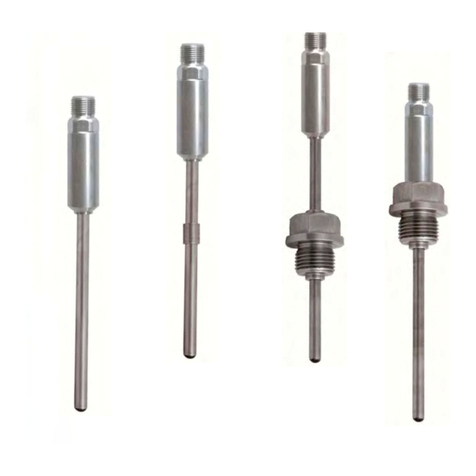
GHM-Messtechnik
GHM-Messtechnik GREISINGER GTF 111-Ex Series User manual
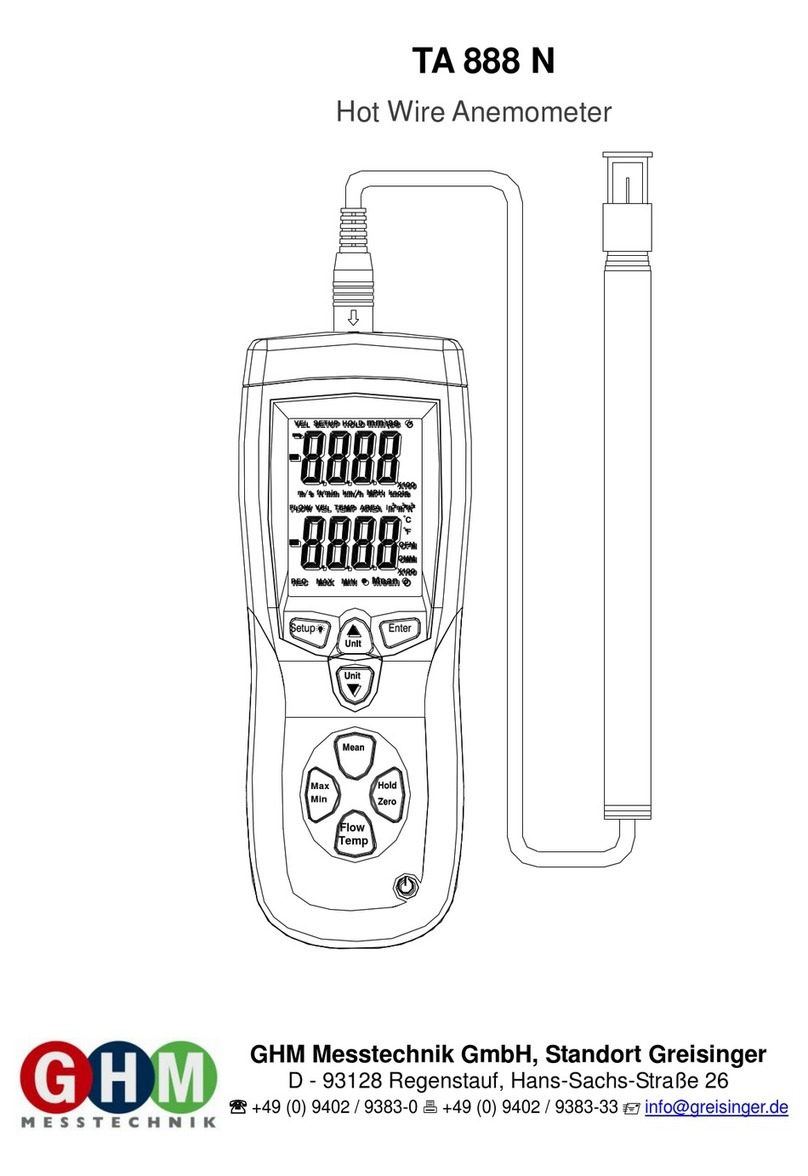
GHM-Messtechnik
GHM-Messtechnik TA 888 N User manual
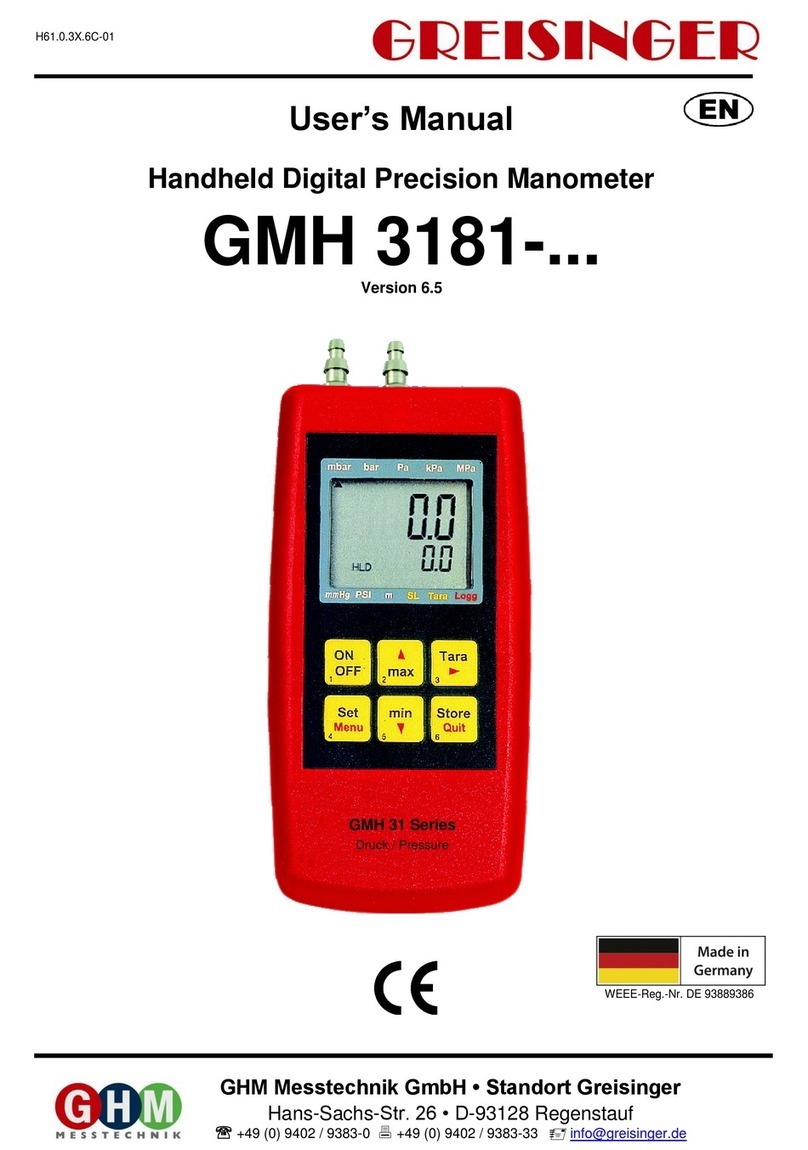
GHM-Messtechnik
GHM-Messtechnik GREISINGER GMH 3181 Series User manual
